Another outing for a ukulele brand I looked at fairly recently. This is the unusual looking Mr Mai ML-T Tenor Ukulele.
Mr Mai are a Chinese company who recently lent me the rather lovely Le Petit Prince Ukulele which reviewed rather well. At the same time they sent this review model over to look at which is much more traditional in some ways, but not in others! I think you can see what I am getting at.
This is a pretty standard shaped and scaled double bout tenor with an attractive dropped shoulder to create a 'cutaway' in the body. The top is all solid and the back and sides are laminate. First gripe - and that is down to the product description. Mr Mai list this as Koa but elsewhere in their listing refer to it as Acacia. This stuff matters for the simple reason that whilst all Koa is Acacia (that's the species it is) not all Acacia is Koa. Koa is the term used for trees grown on the Big Island in Hawaii and nowhere else. Whilst you can grow the same tree in, say, Indonesia, it's then no longer Koa. Why does that matter? Well some argue the conditions in Hawaii make for better quality wood (though I expect that is a subjective observation), but the less subjective is the fact that Hawaiian Koa is MUCH more expensive than Acacia. I contacted Mr Mai and they tell me this is eastern Acacia. As such, using the term Koa is naughty and they should change it.
STOP PRESS - Since this review went live, Mr Mai have amended they product description to name this as Acacia, not Koa.
The body is made of two pieces of solid wood on the top and two pieces of laminate on each of the back and sides. When I put up a 'sneak peek' picture of this on the socials one or two people said it looked like laminate. And then I looked closer at the soundhole edge myself and I too started to think it was laminate. Please tell me this isn't another product description issue.... Now, you will know that I look inside instruments so hold that thought and you will see my comment below when we go inside. Anyway, I rather like the look of the wood, particularly on the top on this example which is rich in colour and whilst it doesn't have a great deal of stripe or flaming, it's attractive enough. It's all nicely bookmatched too.
The body is made of two pieces of solid wood on the top and two pieces of laminate on each of the back and sides. When I put up a 'sneak peek' picture of this on the socials one or two people said it looked like laminate. And then I looked closer at the soundhole edge myself and I too started to think it was laminate. Please tell me this isn't another product description issue.... Now, you will know that I look inside instruments so hold that thought and you will see my comment below when we go inside. Anyway, I rather like the look of the wood, particularly on the top on this example which is rich in colour and whilst it doesn't have a great deal of stripe or flaming, it's attractive enough. It's all nicely bookmatched too.
The bridge is made from ebony and is a tie bar that seems finished very well if a little pale for my tastes in ebony. In fact it looks largely the same as the bridge on the Little Prince uke. It too is fitted with a bone saddle with a compensated top. String spacing here is 41mm.
Then we come on to the more unusual. We have three sound holes on this instrument! There are two smaller holes on the top face in the upper bouts which I rather like. I've seen offset holes in that area before but not that often have I seen two of them (Mele make one I believe) and I like how they are slightly different sizes. It does give the ukulele a look of a face though, and whilst I'm not minding that it may divide opinion. The third hole is a side sound port but in the lower bout not the upper and cut in a kind of teardrop shape. Nice. And there's another reason I am pleased the side port is in that position - the top soundholes here would make it a real pig to fit a pickup or repair loose braces due to access, so the side port is a boon for that! Decoration is the form of ebony top and back binding with white purfling and an abalone inlay around the top and sound hole edges. I think it all works rather well and doesn't appear too blingy. The whole thing is then finished in a well done, slightly open pore satin.
Inside is easy to inspect on account of the side port. It's very tidy in here with braces that are not too heavy and notched kerfing. And that comment about whether the top was actually solid or not? I believe it really is solid. The grain on the top clearly matches the grain inside. But what about that sound hole edge? That really looks like laminate.. Well, Mr Mai have a strengthening veneer of wood above the top brace and running around and between the two soundholes. You can see the solid wood on the picture below which is the darker wood on the left, and the support veneer is the paler material on the right. I presume that is there to strengthen the top on account of the holes, and to my eyes accounts for the laminate 'look' on the edges. Phew.. I will say though, even when you take the veneer inner layer into account the top still looks quite thick..
The neck on this one is made of okoume in three pieces with well hidden joints. We have an ebony heel cap and it's finished in satin like the body. The nut profile isn't too rounded and it tapers down to a comfortable 37mm with 30mm from G to A. One thing I don't like about the neck is that it is so yellow looking in colour which I think looks odd against the brown body. I'd like it darker.
Topping that is an ebony fingerboard, also on the paler side like the bridge but in very good condition. It is set with 18 frets joined at the 14th and they are all dressed ok. Stylised 'leaf/flower' pattern inlays in pearl sit in the 3rd, 5th, 7th, 10th, 12th and 15th spaces and these are paired with white dots down the side of the bound fretboard.
The bone nut is cut well and beyond that is a slot head faced in more ebony. I've said I don't like the Mr Mai logo that much before and it's the same one here, inlaid in paler wood in the top face. The whole headstock is very tidy though.
Tuners are the usual side mounted open gears in black with gold gearing. They are unbranded but seem to be good quality on the metalwork.
Completing the package are a set of D'Addario Titanium strings, a branded padded gig bag and a sound hole humidifier. And that is currently listed on the Mr Mai site at $287, and (due to the usual parity we see in the UK) in UK shops at £299. Speaking as a Brit I consider that price too high despite the good build, finish and appointments here. You can easily get a solid top only tenor instrument from the likes of Kai, Uma and Snail for far less than the asking price here. I'd say it should be in the £150 - £200 range myself. By the way, it's also available with an active pickup system for a bit more money, but I'd save that and fit your own passive if you want to plug in.
So apart from some irritation with the product specification and the fact I think it's too expensive there's not much wrong here with the build and finish. It all feels very stable in the hands, is not heavy at 555g and balances ok as well. Setup on this example also reached me without need for adjustment.
Volume here is very good and you will not struggle to heard. The side sound port also help through the noise up to your lug-holes. Sustain though is only average and falls off quite quickly. I'd like that to be better.
Tone is what I would expect from Acacia with a rich jangly character to the sound. Strummed, the notes are clear and harmonise well with each other giving it a peppy, fizzy sound that is really rather nice. The average sustain probably adds to that peppy staccato sound so it's not all bad news. It is a touch on the 'thin' side played this way for me and I would like a touch more bass myself though yet it still put a smile on my face. Experimenting with strings may help here.
Fingerpicking is chimey and bell like all over the neck and, whilst again I'd like a touch more sustain here, it creates a very clear pretty tone. I think I prefer it played that way. It's also very comfortable to play this way for my hands.
Summing things up, this is a pretty looking, well made and well finished instrument. I hope the use of the term 'Koa' is a lost in translation thing because brands shouldn't be ashamed of using the term acacia. And the acacia richness does come through in the tone on what is very nice instrument to play. The price leave me with an eyebrow raised here, but otherwise this is a decent offering from Mr Mai
UKULELE SPECS ROUNDUP
Model: Mr Mai ML-T
Scale: Tenor
Body: Solid Acacia Top, laminate Acacia back and sides
Bridge: Ebony tie bard
Saddle: Compensated bone
Spacing at saddle: 41mm
Finish: Satin
Neck: Okoume
Fingerboard: Ebony
Frets: 18, 14 to body
Nut: Bone
Nut: Bone
Nut width: 37mm, 30mm G to A
Tuners: Unbranded side mounted open gears
Strings: D'addario Titanium
Tuners: Unbranded side mounted open gears
Strings: D'addario Titanium
Extras: Gig bag, humidifier
Country of origin: China
Country of origin: China
Weight: 555g
Price: $287 (£299 in UK)
UKULELE PROS
Interesting looks
Very tidy build and finish
Good volume
Rich acacia tone
Very nice playable neck
UKULELE CONS
Koa?
Would prefer darker ebony and darker neck
Lacking a bit in sustain
Price
Lacking a bit in sustain
Price
UKULELE SCORES
Looks - 8.5 out of 10
Fit and finish - 9 out of 10
Sound - 8.5 out of 10
Value for money - 7 out of 10
OVERALL UKULELE SCORE - 8.3 out of 10
OVERALL UKULELE SCORE - 8.3 out of 10
UKULELE VIDEO REVIEW
GOT A UKULELE IS NOT PAID BY BRANDS OR SHOPS - YOUR KIND DONATIONS ARE WHAT KEEP THE SITE GOING! THANKS FOR YOUR HELP!
SAY THANKS WITH A BEER!
BECOME A GOT A UKULELE PATREON
OR
THANKS!

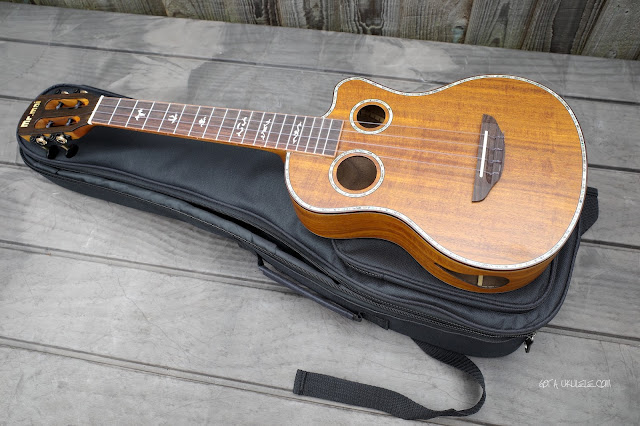
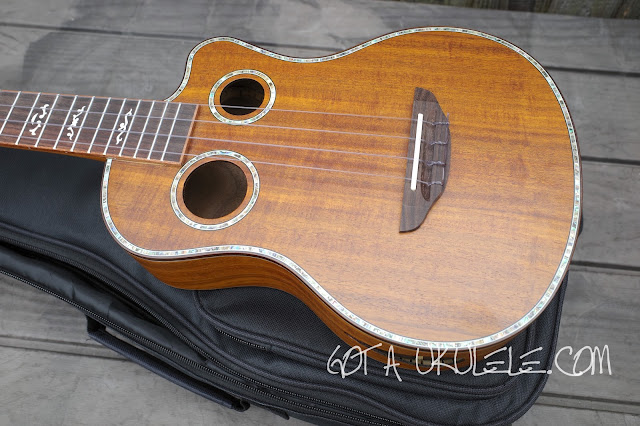
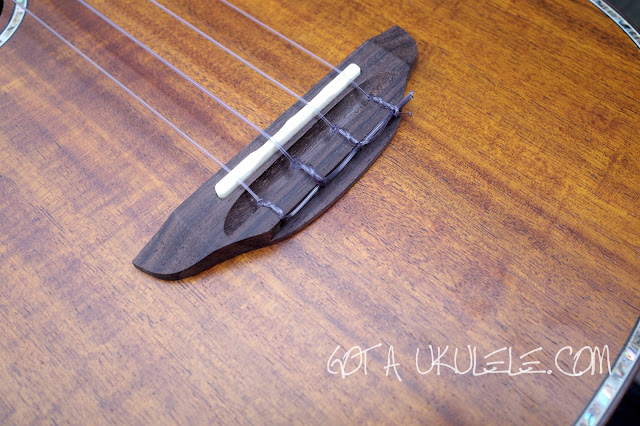

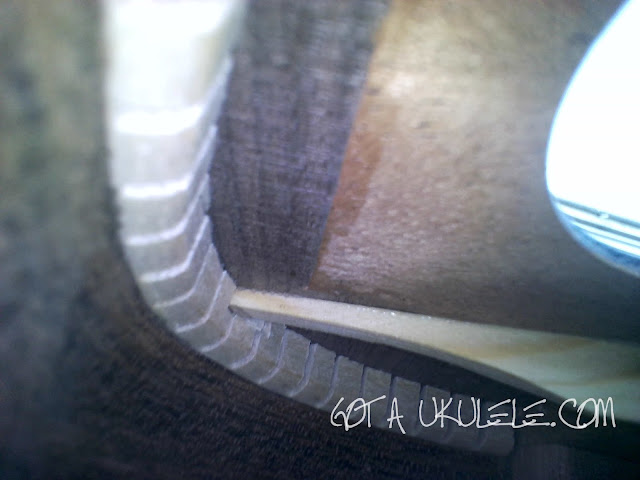
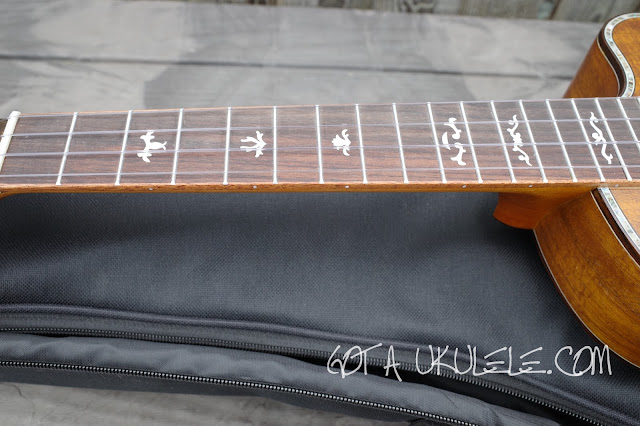

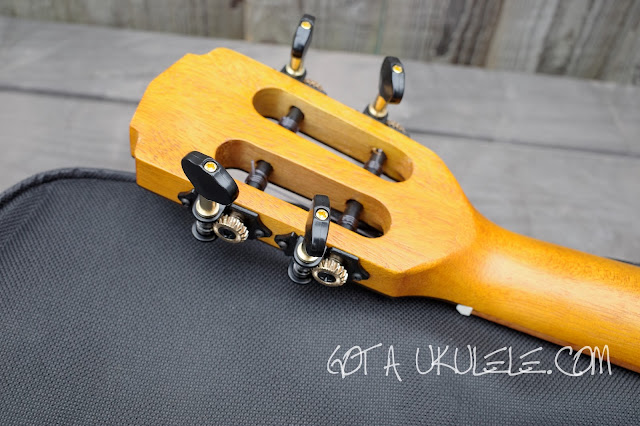

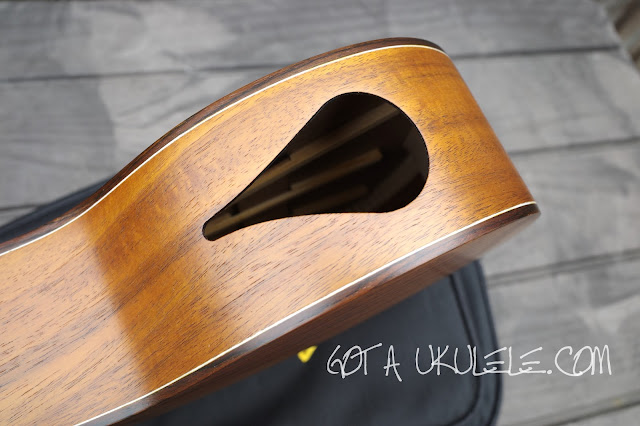

Excellent, honest and objective review with a commendable call out about the misuse of Koa in the description. It's pretty for sure but I must agree that the price is too high. Thanks, Baz.
ReplyDelete